

The Icelandic Debt Relief. The hottest story coming from Iceland now is the one about the government-initiated debt relief to households.
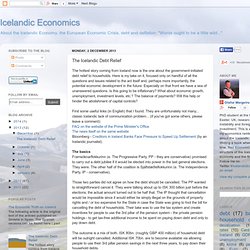
Here is my take on it, focused only on handful of all the questions and issues related to the act itself and, perhaps more importantly, the potential economic development in the future. Especially on that front we have a sea of unanswered questions. Is this going to be inflationary? What about economic growth, unemployment, investment levels, etc.? Iceland – back in growth but at the mercy of foreign markets at Sigrún Davíðsdóttir's Icelog. What is actually going on in Iceland. Because I’m tired of you people spreading untruths Since people continue to spread the factually dubious statement that Iceland “told creditors & IMF to go jump, nationalised banks, arrested the fraudsters, gave debt relief and is now growing very strongly, thanks” I find I have to write this here thing.

(This specific example comes from twitter but is almost identical, word for word, to the standard ‘Iceland is an economic utopia’ mantra that is being repeated ad nauseam.) Because, for some reason, people won’t believe Icelanders when they say that the above is not quite the reality as most Icelanders experience it. 1. Iceland told IMF to go jump, go away, left the IMF program etc. No it didn’t. (Too much to read? Iceland: The broken economy that got out of jail - Business Analysis & Features, Business. Iceland experienced one of the most severe recessions in the world when the markets crashed in 2008.

Economic output fell by about 12 per cent over two years. But the latest report on Iceland by the International Monetary Fund shows that growth is resuming. GDP is expected to increase by a relatively healthy 2.5 per cent in 2011. The Icelandic public finances are on a sustainable path too with government debt projected to fall to 80 per cent of GDP in 2016. Iceland rises again as Ireland sinks. Iceland's central bank today cut its headline interest rate, giving a signal that the island's bankrupted economy was edging back towards health.
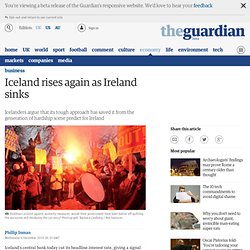
The country's base rate fell one percentage point to 4.5%, after figures showed the economy growing at a faster pace than expected after seven successive quarters of contraction. But while a resurgent Icelandic economy means rising income levels for the country's 320,000 inhabitants, it causes problems for Irish politicians. In European Crisis, Iceland Emerges as an Island of Recovery. Iceland: Was the IMF programme successful? Iceland has just become the first industrialised country to graduate from an IMF programme in over 30 years.
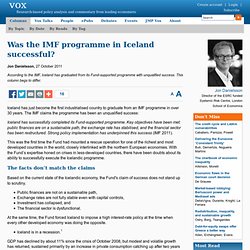
The IMF claims the programme has been an unqualified success: Iceland has successfully completed its Fund-supported programme. Key objectives have been met: public finances are on a sustainable path, the exchange rate has stabilised, and the financial sector has been restructured. Iceland’s programme with the IMF 2008–11. When Iceland’s three main banks collapsed on 7–9 October 2008 it became obvious that Iceland would suffer a balance-of-payments crisis unless it could get outside support.
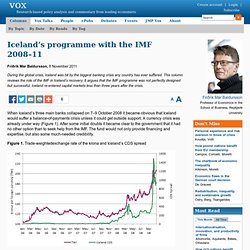
A currency crisis was already under way (Figure 1). After some initial doubts it became clear to the government that it had no other option than to seek help from the IMF. The fund would not only provide financing and expertise, but also some much-needed credibility. Figure 1. Houston, we have a problem: Iceland’s capital controls. Following the collapse of Lehman Brothers in 2008, the first country to freeze was Iceland.
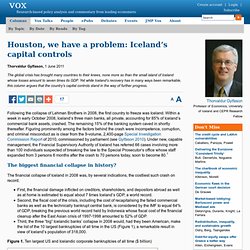
Within a week in early October 2008, Iceland‘s three main banks, all private, accounting for 85% of Iceland’s commercial bank assets, crashed. The remaining 15% of the banking system caved in shortly thereafter. Figuring prominently among the factors behind the crash were incompetence, corruption, and criminal misconduct as is clear from the 9-volume, 2,400-page Special Investigation Commission Report of 2010, commissioned by parliament (see Gylfason 2010). Under new, capable management, the Financial Supervisory Authority of Iceland has referred 66 cases involving more than 100 individuals suspected of breaking the law to the Special Prosecutor‘s office whose staff expanded from 3 persons 6 months after the crash to 70 persons today, soon to become 80.1.
Iceland Tightened Krona Controls to Prevent Speculative Chaos. Iceland pushed through stricter capital controls yesterday to clamp down on speculative trading and support the krona as it seeks to emerge from its 2008 economic collapse.

“We were making sure that the controls wouldn’t be unwound in a chaotic manner which might lead to instability,” Arnor Sighvatsson, deputy governor at the Reykjavik-based central bank, said yesterday in a phone interview. Loopholes in the legal framework posed a risk that “was becoming too great and if we didn’t step in it could have become uncontrollable.” Iceland tightened controls on inflation-linked debt and on creditors of Kaupthing Bank hf, Glitnir Bank (GLB) hf and Landsbanki Islands hf. The law, which was rushed through parliament after markets closed on March 12, is designed to avoid a krona sell- off as controls on other currency transactions are eased. Central Bank of Iceland preparing to remove currency exchange restrictions. The dark sides of Iceland's revival. How not to resolve a banking crisis: Learning from Iceland’s mistakes. Much of macroeconomic policymaking is trial and error.
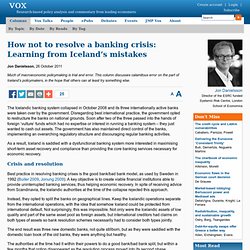
This column discusses calamitous error on the part of Iceland’s policymakers, in the hope that others can at least try something else. The Icelandic banking system collapsed in October 2008 and its three internationally active banks were taken over by the government. Disregarding best international practice, the government opted to restructure the banks on national grounds. Why Iceland Has No Hope (BJ) - Iceland Review Online. When members of Althingi, led by the President and Prime Minister of Iceland, decided to take the walk through a barrage of eggs and tomatoes, I became convinced that Iceland has no hope. Who would decide to literally put themselves in the line of fire except a bunch of idiots? Of course I don’t mean that every member of the procession has low intelligence. That is not true. Some of them are quite capable as individuals.
But the current atmosphere seems to bring out the worst in many people, including politicians as a group. Survey: Iceland's Recovery: Can the Lessons Be Applied Elsewhere? The Icelandic government and the IMF are co-hosting a conference in Reykjavik to take stock of Iceland’s crisis and recovery (photo: ZUMA Press/Newscom) IMF Survey online October 24, 2011 International conference to look at lessons learned in Iceland and challenges ahead Modest recovery under way, with declining unemployment $2.1 billion IMF-supported program expired in August this year.
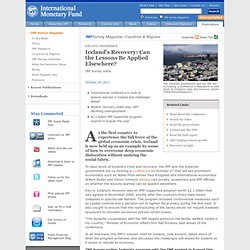
Islande : la reprise a une sale dette. Après trois années de récession, l’Islande sort doucement la tête de l’eau. Douloureusement et sans crier victoire. Certes, le rapport du Fonds monétaire international (FMI) publié en fin de semaine dernière lui accorde un satisfecit encourageant. Mais, malgré un retour à la croissance (+ 3% sur 2011 contre - 9% en 2009) et un taux de chômage en recul (6% aujourd’hui, contre 9% en 2010), la santé de cette minuscule nation de 326 000 habitants reste fragile. Vie à crédit. Précipitée dans la crise en octobre 2008, dans la foulée de la faillite de Lehman Brothers, l’Islande a été victime de son système bancaire hypertrophié. Malgré des progrès importants réalisés dans la restructuration de la dette des ménages et des entreprises, l’endettement privé reste préoccupant.
Tout le monde est concerné. Soucieux de ne pas abandonner les citoyens les plus en difficulté, le gouvernement de gauche de Johanna Sigurdardottir a créé en août 2010 un «Bureau des endettés». Aluminium. The Icelandic Trader: The Icelandic economic recovery. Icelandic Anger Brings Debt Forgiveness in Best Recovery Story. Did Iceland forgive the majority of its citizens’ mortgage debt? An unbelievable story, the source of which appeared to be a single Spanish-language news broadcast, made the blogosphere rounds yesterday: Iceland is forgiving nearly all of its citizens’ mortgage debt!